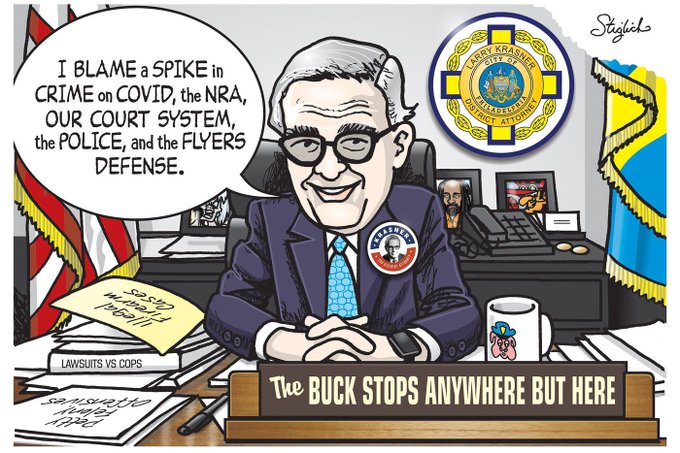When I wrote on Saturday that there must’ve been at least 133 souls sent early to their eternal rewards by the end of Friday, April 9th, based on a story in The Philadelphia Inquirer, I realized that it could have been an undercount. The Philadelphia Police Department’s Current Crime Statistics page is only updated on the weekdays, so I knew the numbers when I checked this morning could be a surprise. I did check the Inquirer’s website several times yesterday, but saw no stories on city murders beyond the one referenced above.
But I will admit it: I hadn’t guessed that there would have been 139 homicides by the end of Sunday, April 11th! The above linked Inquirer story began with, “Two men are dead and six others injured in a total of five shooting incidents in less than nine hours Friday night into Saturday morning throughout Philadelphia, police said.” If there were no other attempted homicides, that could mean that five of the six wounded expired over the weekend, or it could mean that there were more murders, unreported by the Inquirer, over the weekend.
No matter: I’ve said it several times: to the editors of the Inquirer, killings in Philadelphia aren’t newsworthy unless the victim is a child, someone who was a ‘somebody,’ or a cute little white girl. We need to stop pretending that #BlackLivesMatter because in the City of Brotherly Love, it’s very apparent that they don’t.
Of course, the Inquirer did mention the homicide rate, just not in the context of the victims:
Philly DA Larry Krasner and challenger Carlos Vega enter election homestretch as gun violence surges
Krasner’s reelection campaign against primary challenger Carlos Vega is a key test for the reform movement that helped make him one of the most liberal big-city prosecutors in the country.
by Chris Brennan | April 12, 2021
Philadelphia District Attorney Larry Krasner is pitching his reelection campaign as a fight for criminal justice reform — and against a return to injustices of the past.
“Do you want the future, where we are going to continue to keep those kinds of promises?” Krasner, 60, asked voters during a candidate forum last month, citing his reform-based 2017 campaign. “Or do you want the past?”
Carlos Vega, his challenger in the Democratic primary, is offering voters a hybrid: A reform-minded, experienced homicide prosecutor who says Krasner is making the city “vulnerable and unsafe.”
“We need a more responsible approach to criminal justice reform, as well as prosecuting violent criminals,” Vega, 64, told the same Philadelphia Bar Association forum. “Four years ago, we were promised that, through justice, we’d have a safer city. Philadelphia is more dangerous now than it’s been in the last three decades.”
There’s a lot more at the original, but one thing stands out: ‘progressive’ law enforcement has not been law enforcement at all!
An Inquirer analysis last month found that although arrests for illegal gun possession have nearly tripled during Krasner’s time in office, conviction rates have fallen from 63% to 49%.

We’ll see if the editors endorse Republican Chuck Peruto in the general election if Mr Krasner wins the Democratic primary.
“If you don’t believe punishment is a deterrent to crime, then leave,” Peruto said. “Because you’re stupid. Crimes must have consequences.”

Philadelphia Police Officers and FOP members block District Attorney Larry Krasner from entering the hospital to meet with slain Police Corporal James O’Connor’s family, because Mr Krasner’s policies had kept Corporal O’Connor’s killer out on the street in the first place..
One of the people who wasn’t in jail on Friday, March 13, 2020, was Hasan Elliot, 21. How did the District Attorney’s office treat Mr Elliot, a known gang-banger?
- Mr Elliott, then 18 years old, was arrested in June 2017 on gun- and drug-possession charges stemming after threatening a neighbor with a firearm. The District Attorney’s office granted him a plea bargain arrangement on January 24, 2018, and he was sentenced to 9 to 23 months in jail, followed by three years’ probation. However, he was paroled earlier than that, after seven months in jail.
- Mr Elliot soon violated parole by failing drug tests and failing to mate his meetings with his parole officer.
- Mr Elliott was arrested and charged with possession of cocaine on January 29, 2019. This was another parole violation, but Mr Krasner’s office did not attempt to have Mr Elliot returned to jail to finish his sentence, nor make any attempts to get serious bail on the new charges;he was released on his own recognizance.
- After Mr Elliot failed to appear for his scheduled drug-possession trial on March 27, 2019, and prosecutors dropped those charges against him.
On that Friday the 13th, Police Corporal James O’Connor IV, 46, was part of a Philadelphia Police Department SWAT team trying to serve a predawn arrest warrant on Mr Elliott, from a March 2019 killing. Mr Elliot greeted the SWAT team with a hail of bullets, and Corporal O’Connor was killed. Had Mr Elliot been in jail, as he could have been due to parole violations, had Mr Krasner’s office treated him seriously, Corporal O’Connor would have gone home safely to his wife that day.
That is what the City of Brotherly Love has for a District Attorney! Mr Krasner is more concerned about not locking up people than he was with the safety of both police officers and civilians, and Corporal O’Connor is stone-cold graveyard dead because of it.
‘Progressive’ policies have encouraged criminal behavior. When idiotic prosecutors like Mr Krasner don’t try to seriously punish lesser crimes, the bad guys remain out on the streets, and move on to bigger and badder crimes, and decent people get killed. Real #socialjustice would be trying to make neighborhoods, and, let’s face it, in Philadelphia we mean poorer, minority neighborhoods, safer for the people living there.







